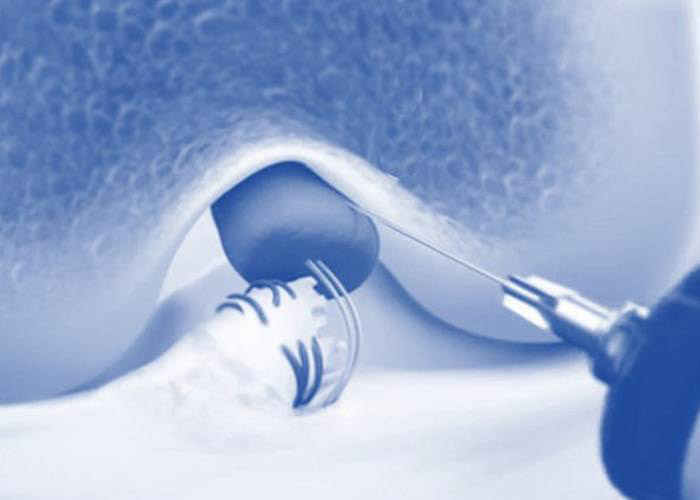What is Bridge-Enhanced ACL Repair (BEAR)?
Bridge-Enhanced ACL Repair (BEAR) is a surgical technique that uses a special sponge-like scaffold to encourage the healing of the injured Anterior Cruciate Ligament (ACL). This procedure is considered an adjunct to primary ACL repair. This specific procedure involves placing a scaffold, derived from cow (bovine) tissue, across the torn ends of the injured ACL. The scaffold is in place by sutures and acts as a healing bridge while the torn ends of the ligament attempt to grow back together and heal. Doctor Riley J. Williams provides diagnosis as well as surgical and nonsurgical treatment options for patients in Manhattan, Brooklyn, New York City and surrounding areas who need expert advice regarding the BEAR Repair.

Gunter Sokoi, CC BY-SA 4.0, via Wikimedia Commons
When is Bridge-Enhanced ACL Repair (BEAR) recommended?
The BEAR implant is an experimental treatment. The BEAR may be recommended as an alternative to traditional ACL reconstruction for patients with partial or complete tears of the ACL who are between the ages of 14 and 35 and have not undergone previous ACL surgery. The procedure may also be performed within a few weeks of the injury.
How long has Bridge-Enhanced ACL Repair (BEAR) been available?
BEAR’s testing in human patients began with a preliminary clinical trial several years ago. Since then, a number of larger clinical trials have been conducted. The long durability of patients treated with ACL repair and the BEAR implant is unknown.
Why is Bridge-Enhanced ACL Repair (BEAR) recommended instead of ACL reconstruction?
In contrast to traditional ACL reconstruction surgery that involves harvesting a donor graft to replace the injured ACL , the BEAR procedure features a scaffold that encourages the body to primarily heal the torn ligament. The procedure BEAR is performed on an outpatient basis. The surgery itself is slightly less invasive compared to traditional ACL reconstruction. The BEAR is considered an adjunct to primary ACL repair.
What are the risks of Bridge-Enhanced ACL Repair (BEAR)?
The biggest risk of Bridge-Enhanced ACL repair is the increased risk of graft failure compared to traditional ACL reconstruction. Patients who regularly participate in higher demand pivoting sports should consider this when selecting a treatment strategy for their ACL surgery.
Otherwise, the BEAR procedure carries the same risks as most surgeries, including infection, bleeding, nerve damage, and blood clots.
What is the success rate of Bridge-Enhanced ACL Repair (BEAR)?
The success rate of BEAR is dependent on several factors including the extent of the ACL tear, the age of the patient, and the level of physical activity. Clinical studies have shown that the procedure has a success rate of approximately 80% . There is concern about the use of this methodology in young athletes who play pivoting sports (basketball, soccer, lacrosse, football, downhill skiing, gymnastics).
The Bridge-Enhanced ACL Repair (BEAR) procedure is a relatively new option in the treatment of ACL injuries. More clinical studies are needed to ensure the long-term durability and clinical success rates of primary ACL repair using the BEAR implant. Currently the clinical outcomes of the BEAR procedure do not match those observed with traditional ACL reconstruction surgery.
BEAR – Bridge-Enhanced ACL Repair Surgeon

Bridge-Enhanced ACL Repair (BEAR) is a new(er) surgical method of repairing an ACL that features a scaffold which encourages the body to primarily heal the torn ligament. The BEAR method is not the best procedure for some patients and it is best to talk with an expert to see if this would be the best treatment for your torn ACL. ACL surgeon, Doctor Riley J. Williams provides diagnosis as well as surgical and nonsurgical treatment options for patients in Manhattan, Brooklyn, New York City and surrounding areas who have sustained an ACL injury. Contact Dr. Williams’ team today!
